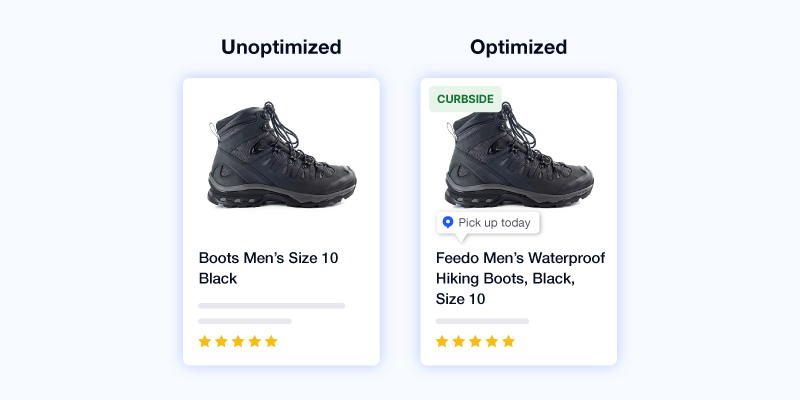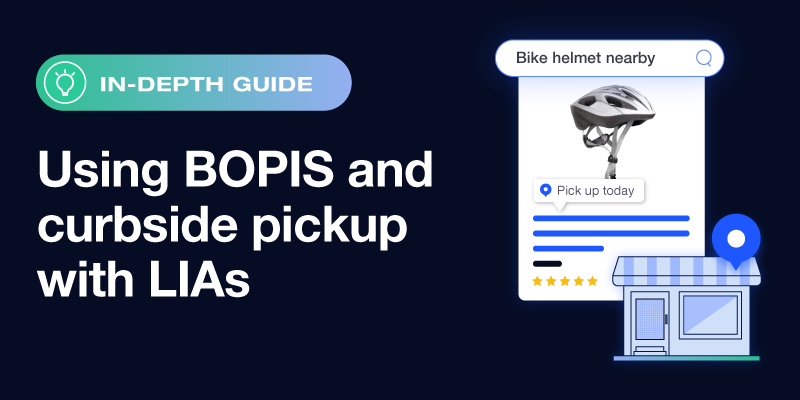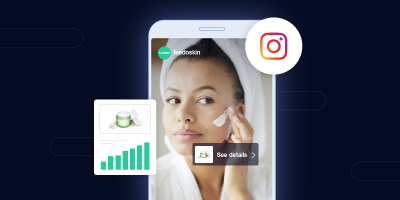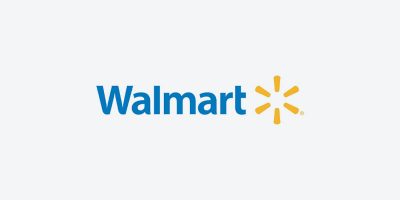Buy online, pick up in store (BOPIS) and curbside pickup became popular options during the pandemic, but consumers who got used to these fulfillment services clearly still find them convenient. Nearly one-third of U.S. ecommerce shoppers picked up their most recent online purchase in-store or via curbside pickup, according to a 2023 study by PYMTS.
While you don’t have to set up local inventory ads (LIAs) to offer BOPIS or curbside pickup, many businesses use LIAs to highlight that these fulfillment options are available. This helps stores drive more customers to their physical locations and promote fulfillment methods that decrease the costs associated with last-mile delivery.
You can choose to offer your customers BOPIS, curbside pickup, or both. Learn about the benefits and challenges associated with these options, and how LIAs can be enhanced with a feed management platform.
Buy online, pick up in store (BOPIS)
Some consumers find the option to make purchases online and pick up those products in-store more convenient than delivery because they’re able to get their products faster—in a matter of hours rather than days. Businesses also benefit from the reduction of delivery costs and added in-store traffic with BOPIS.
Customers who come into your store to pick up an order are more likely to make additional unplanned purchases, especially if you set up your store to entice last-minute sales. This also gives you the opportunity to connect with them by showcasing your in-store branding and exceptional customer service, thereby creating a more personable experience than what is achievable digitally.
To make this all work, your staff needs to be trained to manage the BOPIS system, including order handling and customer service. You also need to think about how you want customers to pick up their orders once they’re in your store, including a dedicated pickup spot and an area for your staff to stage orders in advance of your customers’ arrival.
Curbside pickup
While BOPIS is still the most popular choice amongst consumers, curbside pickup has been the fastest growing, with 66% year-over-year growth in 2022 compared to 2021, according to the same PYMTS study; that’s about six times faster than BOPIS grew over the same period.
Curbside pickup offers an ideal solution for customers who have mobility issues, limited time, small children, or those who wish to minimize contact due to health concerns. It’s more convenient than BOPIS—customers simply park in a designated spot, receive their items, and leave without needing to navigate through the store.
Since engagement with customers consists of loading items into the vehicle or handing them off, you have a very short window to leave a meaningful impression. You also miss out on opportunities to drive additional sales, but you are offering convenience to customers who might be seeking out curbside pickup specifically.
If your business has a large parking lot, you need a system that allows you to identify customers waiting to pick up orders. Some businesses designate certain parking spots for curbside pickup, while others allow customers to enter their car details (color, make, model) so that staff can identify the right vehicle. Your employees also need to be trained to deliver orders promptly to the customer’s vehicle and pack things securely so that the trip home does not result in damaged goods.
Leverage feed management with LIAs for BOPIS and curbside pickup success
BOPIS and curbside pickup are not mutually exclusive; both options can be made available to customers. By integrating LIAs into your omnichannel strategy with a feed management platform, you can make sure that shoppers know you offer BOPIS and curbside pickup.

LIAs require efficient inventory management, optimized product listings, and accurate data. For example, if your in-store stock information is inaccurate and customers are able to purchase items that you don’t have, you can quickly lose customer trust when you have to offer a replacement item or cancel the order. Implementing LIAs with the help of a feed management platform can improve and safeguard these processes in multiple ways:
Synchronize in-store stock with your channels: For your LIAs to work effectively, you need to synchronize your in-store product information with your LIA channels. Doing this manually is inefficient and prone to human error, especially if you have several store locations requiring frequent updates.
Feed management platforms allow you to automatically update your in-store stock levels and product information across multiple channels, ensuring that your customers see accurate information about product availability.

Automate channel listings: To enable LIAs, product feeds must contain several attributes: IDs, titles, descriptions, image links, GTINs, brand names, excluded destinations, store codes, quantity, and prices.
However, just filling in these attributes may not be sufficient to provide customers with an optimal pickup experience. The pickup method and pickup timeline are additional attributes that give customers relevant information needed to make a purchase decision.
Use a feed management platform to automate the listing process and ensure that your ads are accurate and optimized to improve search relevancy.

Safeguard operations: A common problem that merchants face is keeping data up-to-date across multiple channels. With LIAs this becomes even more crucial, as the timeline from purchasing the product to receiving it is dramatically shortened.
This makes robust data safeguards like inventory buffers, which allow you to display less stock than you have available, crucial to customer satisfaction and operational success. Why would you want to show less inventory than you have?
If you have a low stock quantity for a popular product, there’s a chance that customers shopping in the store could buy it up before your ads are updated with the newly available quantities. An inventory buffer allows you to choose when to display a product as out of stock, such as when the available quantity dips below five units.
Use Feedonomics for LIA success
Our full-service product feed management platform allows you to tackle common feed-related problems with local inventory ad campaigns. Leverage our powerful platform and team of channel experts to streamline, optimize, and safeguard your LIAs.
Learn what the full-service difference can do to safeguard your LIAs.

With its leading data feed management platform, Feedonomics helps brands, retailers, and agencies optimize and list products on hundreds of shopping destinations around the world. Learn more about our full-service solutions for advertising channels and marketplaces.




